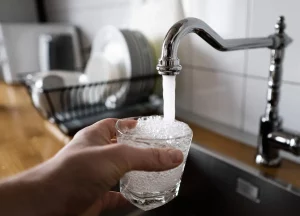Built-in water filters make refrigerators seem like a bargain. A fridge is essential, so why not get one that filters your water too? A refrigerator water filter can be an effective way to protect your family from harmful contaminants in drinking water.
Many Americans have adopted refrigerator water filters as a standard feature. They are designed to remove various impurities from water such as those that can cause bad tastes or odors. They keep the water lines and other parts of your fridge clear from contaminants that can build up in pipes, causing clogging or smelly ice.
Many homeowners rely on these filters to remove toxins such as arsenic and fluoride. While a refrigerator water filter can be a good thing, there may be hidden dangers in drinking water from a fridge.
Continue reading to learn how a refrigerator water filter works and the risks it poses. We also discuss a safer, more reliable, alternative.
How does a regular refrigerator water filter work?
Chloramine and chlorine are two chemicals that kill bacteria, parasites and viruses in tap water. Studies have shown that contaminants can remain in “treated” water after microbes are removed. Some pollutants can escape the municipal filtration systems, or get into the water via leaks and main breaks in the water distribution system.
The refrigerator filters filter the contaminated water as it reaches your home. It then filters the water using a combination carbon and sediment filtration.
Here’s a quick overview of each step:
Sediment filtering: The sediment filter employs mechanical filtration during the sediment filtration stage to trap and remove suspended solids from the filtration system. The sediment filters are able to remove dirt, sand and silt as well as rust flakes and any other suspended solid particles that exceed the filter’s micron-rated size. They reduce cloudiness caused by suspended solids.
Carbon filtration: Refrigerator filters have a carbon block core that is wrapped in a material such as polypropylene. Water flows through the carbon filter from the sediment filter. It passes over large areas of activated carbon, which allows for water adsorption. The activated carbon acts as a magnet and causes contaminants to stick to the media, allowing water to flow through. Built-in refrigerator water filters can remove pesticides and lead, volatile organic chemical chemicals, radon and pharmaceuticals. They also have bad tastes and odors. Their ability to remove these contaminants is dependent on their size and the time spent in contact with the pollutants. A larger filter usually means better filtration.











